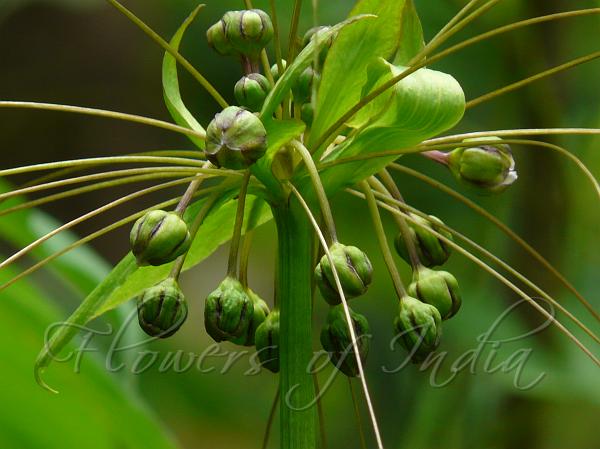|
| Fiji Arrowroot |
|

|

| File size | 1569649 |
| Original date | 7/5/08 12:32 PM |
| Resolution | 2048 x 1536 |
| Flash | Flash did not fire, auto |
| Focal length | 82.8mm |
| Exposure time | 1/200s |
| Aperture | 4.2 |
| Focus Distance | |
| Metering Mode | Multi-segment |
| Camera make | Panasonic |
| Camera model | DMC-FZ18 |
| Sensor type | OneChipColorArea |
|
|
|
|
Photo: |
Botanical name: Tacca leontopetaloides Family: Dioscoreaceae (Yam family)
Synonyms: Tacca hawaiiensis, Tacca involucrata, Tacca pinnatifida
Synonyms: Tacca hawaiiensis, Tacca involucrata, Tacca pinnatifida
Fiji Arrowroot is a perennial herb naturally distributed from western
Africa through southeast Asia to northern Australia. The leaf's upper
surface has depressed veins, and the under surface is shiny with bold
yellow veins. Greenish purple flowers are borne on tall stalks in
clusters, with long trailing whisker-like bracts. The plant is usually
dormant for part of the year and dies down to the ground. Later, new
leaves will arise from the round underground tuber. The tubers are hard
and potato-like, with a brown skin and white interior. The tubers of
Polynesian arrowroot contain starch that was an important food source for
many Pacific Island cultures, primarily for the inhabitants of low islands
and atolls. Polynesian arrowroot was prepared into a flour to make a
variety of puddings.
Medicinal uses: In traditional Hawaiian medicine the raw tubers
were eaten to treat stomach ailments. Mixed with water and red clay, the
plant was consumed to treat diarrhea and dysentery. This combination was
also used to stop internal hemorrhaging in the stomach and colon and
applied to wounds to stop bleeding.
In traditional Hawaiian medicine the raw tubers
were eaten to treat stomach ailments. Mixed with water and red clay, the
plant was consumed to treat diarrhea and dysentery. This combination was
also used to stop internal hemorrhaging in the stomach and colon and
applied to wounds to stop bleeding.
Medicinal uses:
 In traditional Hawaiian medicine the raw tubers
were eaten to treat stomach ailments. Mixed with water and red clay, the
plant was consumed to treat diarrhea and dysentery. This combination was
also used to stop internal hemorrhaging in the stomach and colon and
applied to wounds to stop bleeding.
In traditional Hawaiian medicine the raw tubers
were eaten to treat stomach ailments. Mixed with water and red clay, the
plant was consumed to treat diarrhea and dysentery. This combination was
also used to stop internal hemorrhaging in the stomach and colon and
applied to wounds to stop bleeding. | Identification credit: Dinesh Valke | Photographed at Saphale Ghat, Maharashtra. |
• Is this flower misidentified? If yes,